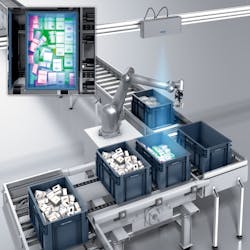Smart Robot Guidance Systems in the IIoT
In the wake of the e-commerce boom, warehouse throughput at fulfillment and distribution centers has become increasingly important. To fill and send orders, a wide range of items need to be handled accurately and at high speeds—and because both worker availability and floor space are limited resources, a premium is placed on fully automated workflows that function within a small footprint.
There are a variety of approaches to address these challenges, but perhaps the most innovative is the introduction of deep learning into the warehouse space. Deep learning, or DL, is a growing subset of machine-learning technologies that enable computers to learn in the same organic way as humans, which is by example. Training machines to recognize subtle differences between similar components allows them to become highly efficient at identifying and sorting them, which is ideally suited to the most fundamental of warehouse processes: bin picking.
Although robots have been incorporated into the bin-picking process for some time, they have worked against significant limitations. A vision-based robot guidance system may be able to locate, with a fair degree of success, objects it has been specifically programmed to recognize within a well-organized environment—yet any given bin might also contain unfamiliar objects with a completely random organization.
From the robot’s point of view, moreover, the organization of the bin changes each time an object is picked. Add to this the fact that there may be other important picking considerations such as an object’s position and orientation, and the scope of the challenge becomes clear. To be sure, secondary processes have been developed to address some of these issues.
A bin-picking task requiring specific part orientation, for example, may make use of a separate 2D camera for verification. If the camera ascertains that the part is facing in the wrong direction, or is upside-down, the guidance system can instruct the robot to release and re-pick. Yet this approach also has the potential to slow down workflow, increase the cost of hardware and require additional floor space.
